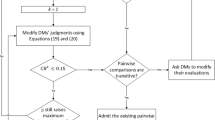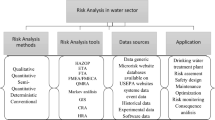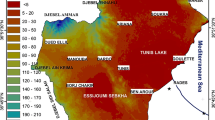Abstract
To analyze the risk of gas overrun in coal mines and improve the risk analysis, a novel risk analysis method was proposed based on FAHP and Bayesian network. The risk analysis framework consisted of causal reasoning, logical reasoning, and sensitivity analysis. The gas overrun risk analysis was conducted by taking the Laohutai Coal Mine in China as the research object. Specifically, based on prior knowledge and sample data, the probability of the gas overrun was 3.2%, belonging to a small probability event. However, the probability of gas concentration exceeding 1% was 12%, and there was still potential danger. Logical reasoning diagnosed and identified that wind speed and air leakage were the direct causes of gas overrun. Sensitivity analysis indicated that wind speed, human error, and ground stress were key factors of the gas overrun. The case study showed this fuzzy analytic hierarchy process (FAHP)-Bayesian network (BN)–based risk analysis method can provide real-time and dynamic decision support for gas overrun control and treatment in coal mines to ensure the safe and efficient mining.









Similar content being viewed by others
Availability of data and materials
All data and materials support our published claims and comply with field standards.
Change history
11 April 2024
Editor's Note: Readers are alerted that the concerns have been raised with this article. Editorial action will be taken as appropriate once this matter is resolved and all parties have been given an opportunity to respond in full.
References
Gu Q, Huang Z et al (2020) An approach for water-inrush risk assessment of deep coal seam mining: a case study in Xinlongzhuang coal mine. Environ Sci Pollut Res 27(34):43163–43176
Henriksen HJ, Rasmussen P et al (2007) Public participation modelling using Bayesian networks in management of groundwater contamination. Environ Model Softw 22(8):1101–1113
Honscha LC, Penteado JO et al (2021) Health impact assessment of air pollution in an area of the largest coal mine in Brazil. Environ Sci Pollut Res. https://doi.org/10.1007/s11356-021-16709-x
Hsu WH (2004) Genetic wrappers for feature selection in decision tree induction and variable ordering in Bayesian network structure learning. Inf Sci 163(1):103–122
Kannan PR (2007) Bayesian networks: application in safety instrumentation and risk reduction. ISA Trans 46(2):255–259
Kim S, Van Tuan N et al (2009) Quantifying schedule risk in construction projects using Bayesian belief networks. Int J Proj Manag 27(1):39–50
Lee E, Park Y et al (2009) Large engineering project risk management using a Bayesian belief network. Expert Syst Applic 36(3):5880–5887
Li H, Tian L, et al. (2020) "Experimental study on coal damage subjected to microwave heating." Rock Mech Rock Eng (3)
Li M, Wang D et al (2020) Experimental study on changes of pore structure and mechanical properties of sandstone after high-temperature treatment using nuclear magnetic. Eng Geol 275:105739
Li M, Wang H et al (2020) Risk assessment of gas explosion in coal mines based on fuzzy AHP and Bayesian network. Process Saf Environ Prot 135:207–218
Li M, Lu Y et al (2021) Piezoelectric effect and ignition properties of coal mine roof sandstone deformation and fracture. Fuel 290:120007
Liwång H (2015) Survivability of an ocean patrol vessel–analysis approach and uncertainty treatment. Mar Struct 43:1–21
Lu J, Li H, et al. (2021) "Microwave-induced microstructure evolution of coal and its effects on the methane adsorption characteristic." Energy Fuels 35(5)
Mahdevari S, Shahriar K, et al. (2014) "Human health and safety risks management in underground coal mines using fuzzy TOPSIS." Sci Total Environ 488-489(s 488–489):85–99
Matías JM, Rivas T et al (2008) A machine learning methodology for the analysis of workplace accidents. Int J Comput Math 85(3–4):559–578
Park HS, Cho SB (2012) Evolutionary attribute ordering in Bayesian networks for predicting the metabolic syndrome. Expert Syst Applic 39(4):4240–4249
Pearl J (1986) Fusion, propagation, and structuring in belief networks.
Pejic LM, Torrent JG et al (2013) A new simple methodology for evaluation of explosion risk in underground coal mines. J Loss Prev Process Ind 26(6):1524–1529
Piniella F, Fernández-Engo MA (2009) Towards system for the management of safety on board artisanal fishing vessels: Proposal for check-lists and their application. Saf Sci 47(2):265–276
Qin L, Ma C et al (2022) Mechanical damage mechanism of frozen coal subjected to liquid nitrogen freezing. Fuel 309:122124
Qin L, Wang P et al (2021) Gas adsorption capacity changes in coals of different ranks after liquid nitrogen freezing. Fuel 292(37):120404
Quanle Z, Han L et al (2020) Rationality evaluation of production deployment of outburst-prone coal mines: a case study of Nantong coal mine in Chongqing, China - ScienceDirect. Saf Sci 122:104515
Saleh JH, Cummings AM (2011) Safety in the mining industry and the unfinished legacy of mining accidents: safety levers and defense-in-depth for addressing mining hazards. Saf Sci 49(6):764–777
Shi L, Wang J et al (2017) A risk assessment method to quantitatively investigate the methane explosion in underground coal mine. Process Saf Environ Prot 107:317–333
Spada M, Burgherr P (2016) An aftermath analysis of the 2014 coal mine accident in Soma, Turkey: use of risk performance indicators based on historical experience. Accid Anal Prev 87:134–140
Tong X, Fang W et al (2018) Application of Bayesian approach to the assessment of mine gas explosion. J Loss Prev Process Ind 54:238–245
Trucco P, Cagno E et al (2008) A Bayesian Belief Network modelling of organisational factors in risk analysis: a case study in maritime transportation. Reliab Eng Syst Saf 93(6):845–856
Uusitalo L (2007) Advantages and challenges of Bayesian networks in environmental modelling. Ecol Model 203(3–4):312–318
Vens C, Struyf J et al (2008) Decision trees for hierarchical multi-label classification. Mach Learn 73(2):185
Vinod G, Bidhar SK et al (2003) A comprehensive framework for evaluation of piping reliability due to erosion–corrosion for risk-informed inservice inspection. Reliab Eng Syst Saf 82(2):187–193
Wu X, Liu H et al (2015) A dynamic Bayesian network based approach to safety decision support in tunnel construction. Reliab Eng Syst Saf 134:157–168
Wu X, Jiang Z et al (2015) Dynamic risk analysis for adjacent buildings in tunneling environments: a Bayesian network based approach. Stoch Environ Res Risk Assess 29(5):1447–1461
Zhang L, Wu X et al (2013) Decision support analysis for safety control in complex project environments based on Bayesian networks. Expert Syst Applic 40(11):4273–4282
Zhang L, Wu X et al (2014) Bayesian-network-based safety risk analysis in construction projects. Reliab Eng Syst Saf 131(3):29–39
Zou Q, Liu H et al (2021) Gas flow laws in coal subjected to hydraulic slotting and a prediction model for its permeability-enhancing effect. Energy Sour Part A Recov Utilization Environ Effects 7:1–15
Funding
This work is supported by National Natural Science Foundation of China (Grant No. 51974299, 52104191); Natural Science Foundation of Hunan Province (2021JJ40204).
Author information
Authors and Affiliations
Contributions
All the authors contributed to the study conception and design. Material preparation, and data collection and analysis were performed by Min Li and Yi Lu. The first draft of the manuscript was written by Shan He and all the authors commented on previous versions of the manuscript.
Corresponding author
Ethics declarations
Ethics approval
I would like to declare on behalf of my co-authors that the work described was original research that has not been published previously, and is not under consideration for publication elsewhere, in whole or in part.
Consent to participate
Manuscript is approved by all the authors for participation.
Consent to publish
Manuscript is approved by all the authors for publication.
Conflict of interest
The authors declare no competing interests.
Additional information
Responsible Editor: Philippe Garrigues
Publisher's note
Springer Nature remains neutral with regard to jurisdictional claims in published maps and institutional affiliations.
Rights and permissions
Springer Nature or its licensor (e.g. a society or other partner) holds exclusive rights to this article under a publishing agreement with the author(s) or other rightsholder(s); author self-archiving of the accepted manuscript version of this article is solely governed by the terms of such publishing agreement and applicable law.
About this article
Cite this article
He, S., Lu, Y. & Li, M. Probabilistic risk analysis for coal mine gas overrun based on FAHP and BN: a case study. Environ Sci Pollut Res 29, 28458–28468 (2022). https://doi.org/10.1007/s11356-021-18474-3
Received:
Accepted:
Published:
Issue Date:
DOI: https://doi.org/10.1007/s11356-021-18474-3




